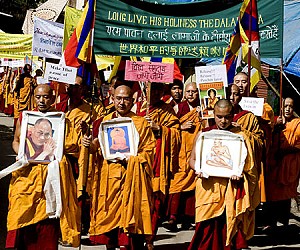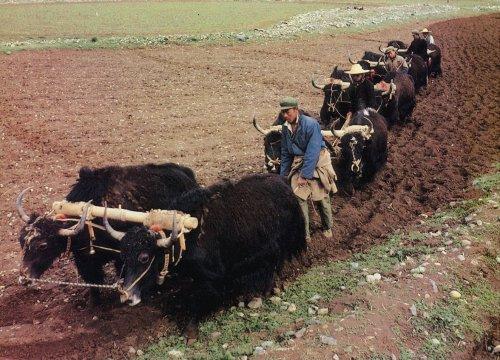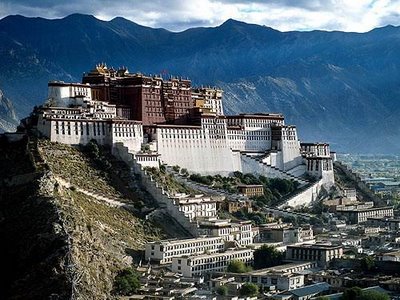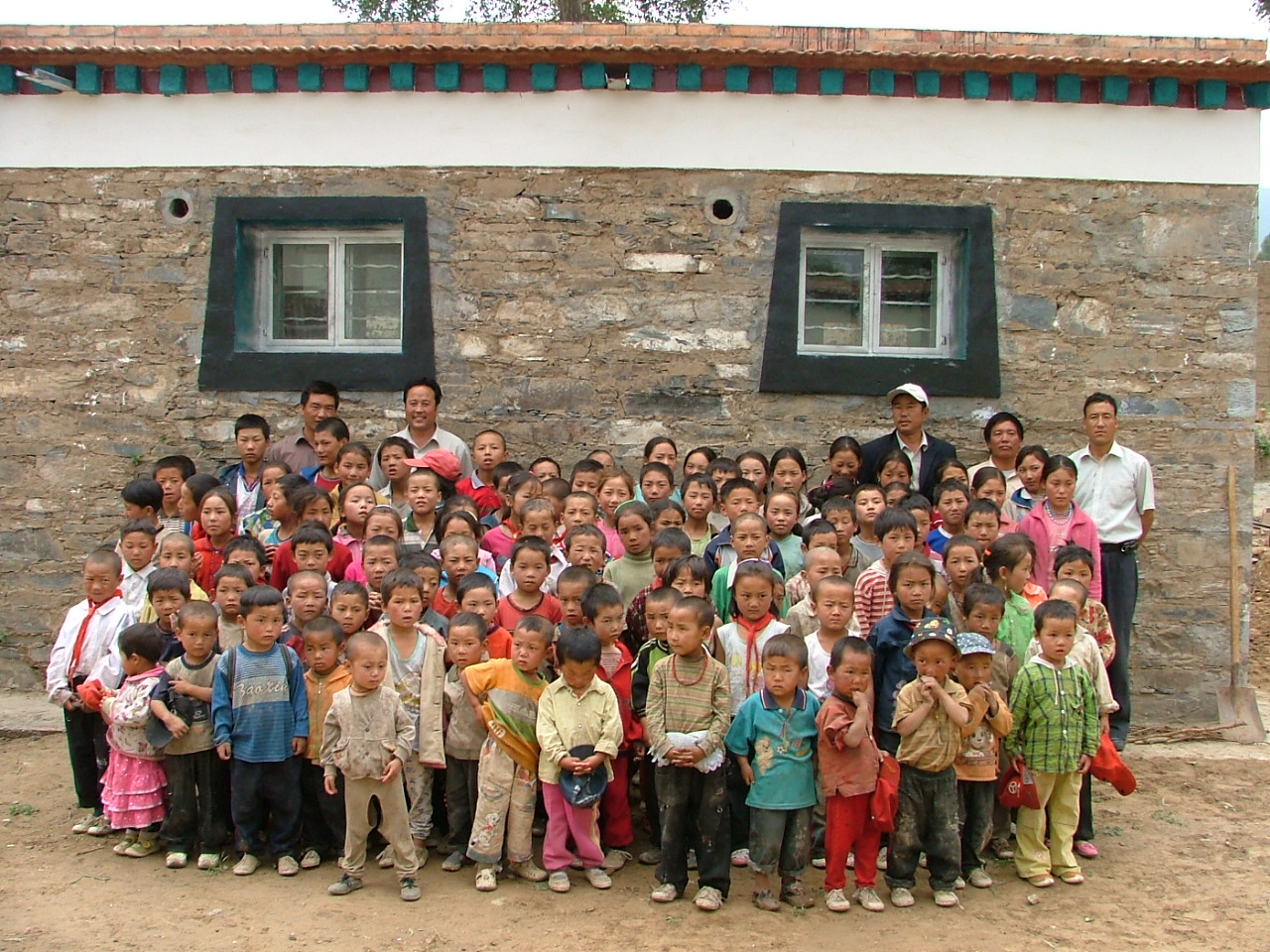Ben Hillman
Both official Chinese and exile Tibetan responses to the protests that broke across Tibet last month followed a familiar, worn-out script. For the Tibetan exiles and their international supporters, this was a last gasp for independence by the victims of cultural genocide. For the Chinese government this was premeditated mayhem orchestrated by the “Dalai clique” and “criminal elements” bent on splitting China. Both sides have it wrong.
Certainly, Tibetan exile flags and “free Tibet” slogans were features of Tibet’s biggest and most violent protests in decades, but it is simplistic to see the widespread discontent on the Tibet Plateau as a bid for freedom by an oppressed people. Protests in Lhasa began with Tibetan monks using the anniversary of the Dalai Lama’s flight into exile (March 10, 1959) to peacefully demonstrate against tight religious controls, including patriotic education campaigns and forced denunciations of the Dalai Lama, but they were soon joined by ordinary Tibetans who used violence against non-Tibetans and their property. Victims included Muslim traders as well as Han Chinese.
As an initial media blackout turned into a media avalanche focused on the violence, many Chinese became confused and angry. Some enraged Chinese bloggers demanded Tibetan blood in return, but most Chinese were simply baffled by what they saw as Tibetan ingratitude for years of central government financial transfers that have resulted in rapid growth in the region’s economy and a surge in incomes.
Indeed, state transfers to Tibetan areas in recent years have been astronomical in proportion to the size of the local economy. Before completing the world’s highest railway in 2006, China announced 180 other major infrastructure projects for the Tibet Autonomous Region worth 77.8 billion yuan (around $10.2 billion) to be constructed during 2006-10. The scale of these investments becomes apparent when measured against the TAR’S GDP, which was 29.1 billion yuan in 2006. In fact, state subsidies account for around 75% of the TAR’S GDP.
Giant injections of state capital in major infrastructure projects have been driving growth in Tibet in recent years, with GDP rising an average of 12% per annum since the launch of China’s Western Development Scheme in 2000. This plan is to expand infrastructure (and markets) to redress growth imbalances between China’s eastern seaboard and the impoverished hinterland, including Tibet. In 2007, the TAR’S GDP grew at a staggering 14% over the previous year. Reportedly, incomes have been rising, too, with double-digit growth recorded in household incomes for both rural and urban residents.
Because of the rosy picture painted by official statistics and the state media, most Chinese are unaware that Tibetans have been among the big losers in the course of China’s economic miracle, and that within Tibetan areas (both the Tibet Autonomous Region and Tibetan autonomous prefectures in the neighboring provinces of Qinghai, Gansu, and Sichuan), the pace of economic modernization has polarized Tibet’s economy. While a minority of Tibetans have been rewarded with state jobs, the majority of Tibetans, who are poorly equipped to access new economic opportunities, have been marginalized.
Tibetans are mostly subsistence farmers and herders. They make a living in an upland rural economy that is much less diversified than other parts of rural China. Further gains in the productivity of staple crops are unlikely without major technological innovation. The already fragile mountain ecosystem is under further pressure from a population that has doubled since the 1950s. [1] In response to these pressures, the state has imposed tough new environmental laws restricting traditional practices such as grazing, hunting and, for a time, logging, all cutting sharply into Tibetan incomes.
Despite the boom in investment, most Tibetans have very limited access to off-farm employment. Unlike China’s eastern regions, surplus low-skilled rural labor is not readily absorbed by secondary industry. Distance and isolation make landlocked Tibetan areas a poor choice for the industrial activity that has been the engine of growth in other parts of rural China. This is true not just for the Tibet Autonomous Region, but for much of China’s western hinterland, including areas populated by Tibetans.
Most of the off-farm employment opportunities created by the boom in state investment are concentrated in the service sector (e.g. administration and tourism) in addition to construction. This has attracted large numbers of economic migrants, who are increasingly free to travel under China’s liberalized labor migration policies. Economic migrants to the cities include Tibetans from rural Tibet, but most are Han Chinese migrants from other provinces.
Most Han Chinese migrants stay only for a few years, save money and return home, but since the 1990s there has been a constant stream of new arrivals. In Lhasa the non-Tibetan population now outnumbers the Tibetan population. Even Tibetan employers in Lhasa and other Tibetan areas admitted to me that they hire non-Tibetans because they are more skilled and more willing to work regular hours for a wage. Many Han Chinese have worked in other Chinese towns before trying their luck in Tibet’s booming urban areas.
So while there is no state-sponsored migration of non-Tibetans to dilute Tibetan culture as Tibetan exiles sometimes claim (more than 80% of Tibetans live in rural areas that have attracted almost no non-Tibetan migration), increasing numbers of Han Chinese are out-competing Tibetans in urban labor markets. Not surprisingly, unemployed rural Tibetan migrants are reported to have been behind some of the worst violence of the protests.
New air and rail links to Tibetan areas have made possible explosive growth in tourism, but even when this tourism is largely based on growing interest in Tibetan culture and Tibetan Buddhism. [2] it has not necessarily translated into opportunities for Tibetans. In one large hotel in an ethnically Tibetan area outside the TAR, hotel managers reported that over 90% of their staff were non-Tibetans recruited from other areas. When I asked for an explanation, the managers cited Tibetans’ dearth of skills, lack of experience in working fixed hours, and a cultural disposition not inclined to obediently comply with hotel guests’ wishes. Even in the housekeeping department, more than 80% of staff was hired from outside the Tibetan autonomous prefecture.
In a more striking example of how the boom in tourism is bypassing Tibetans, when I visited Lhasa’s Potala Palace a few years ago, I was surprised to find a young Han Chinese man dressed in Tibetan costume selling tickets. When I queried him, he laughed and said, “tourists don’t know the difference anyway.” In some places ‘Tibetan’ song and dance troupes sometimes consist of non-Tibetan performers. Tourists mightn’t know the difference, but Tibetans do, and daily experiences like these are sources of a deep and growing resentment.
The reasons why Tibetans are being left behind by the rapid pace of economic development are complex, and do include cultural and language differences. Non-Tibetans have access to wider networks, capital and better information. But there is no systematic discrimination of Tibetans by employers—in fact Tibetans are accorded preferential treatment in state jobs. [3] The labor market, however, operates according to market principles and the most skilled people are getting the jobs regardless of ethnicity. My frequent contact with service industry leaders in Tibetan areas indicates that local employers (Tibetans and non-Tibetans alike) would happily hire Tibetans if they could do the job. Unfortunately, most Tibetans, especially rural Tibetans, simply do not meet employers’ needs.
A central problem is the high rate of illiteracy among Tibetans. While rates vary between the TAR and other Tibetan prefectures, and between urban and rural areas, ethnic Tibetans remain among the most illiterate in China. While enrolments have been rising, only a small minority of the total Tibetan population has some degree of secondary education. The national curriculum is highly academic, demands strong Chinese literacy, and is poorly adapted to rural and regional labor market needs. High school drop-out rates reflect the grim reality that investment in education is not rewarded by jobs, except for a tiny elite that are clever enough to continue to university and state jobs. More than 40% of Tibetans have no formal schooling at all, compared with China’s national average of 8%. [4]
State investment in primary education has increased since 2000, triggering an increase in literacy. But investments in rural education primarily target school construction and wages. The quality of teaching remains poor, as the most capable teachers are reluctant to accept jobs in remote posts. Despite accusations to the contrary, the Chinese government has made increasing efforts to sponsor bilingual education, but this too is a double-edged sword. In many Tibetan primary schools Tibetan is used as the medium of education in the first few years. But because Chinese literacy requires a huge investment in time, students need to switch to Chinese early to have a chance of competing with other Chinese students in higher level entrance exams. Many Tibetans simply never catch up.
The situation is slightly better in urban areas where there are more and better-quality schools and where more Tibetans speak Chinese. In Lhasa many educated Tibetans choose to send their children to Chinese medium primary schools not only because it provides an edge in Chinese language instruction, but also because students at these schools take English as a second language. At the Tibetan medium schools, second language studies are devoted to Chinese. Some have suggested that bilingual policy be extended to require that non-Tibetans in Tibet learn Tibetan before being recruited to state jobs. However, there has been little progress in this direction. It should be noted, too, that outside of Tibet’s monasteries and an urban elite, levels of Tibetan literacy among Tibetans can be as low as, or lower than, levels of Chinese illiteracy.
Perhaps the biggest current challenge for education policy and investment in Tibet is the lack of access to vocational training — the kind of training that will allow Tibetans to compete with migrants from the east in construction, tailoring, food preparation and a host of other jobs in the dynamic service sector. The underinvestment in vocational training is evident in China’s official statistics. While the Chinese government spends twice the national average per capita on education in the TAR, and teacher-student ratios are comparable to those elsewhere, there are half as many secondary schools per capita and only one quarter of the national average of vocational training schools. While there are variations across Tibetan prefectures outside of the TAR, opportunities for vocational training outside of major cities are similarly low or non-existent. [5]
As migrants move in to take advantage of the state-led boom, illiterate and semiliterate Tibetans with few skills suited to off-farm labor become marginalized in their own economy. This is not just a Tibetan problem. Across China inequality is closely linked to skills differentials, as wage increases among highly skilled workers outstrips increases among lower skilled workers. China’s Gini coefficient — a measure of income inequality where “zero” is perfect equality and “one” is perfect inequality — stands at 0.47 making China the most unequal country in Asia after Nepal. The figures reflect not only differences between skilled and unskilled workers but also between workers and farmers, and between rapidly developing coastal areas and poorer inland regions. This is a profound departure from the situation in the 1970s, when China was among the most equal countries in the world. Rising inequality overall has leveled off somewhat in recent years, but it remains at high levels.
While recent evidence suggests that inter-regional inequality may be narrowing, inequality is increasing within many regions, especially between urban and rural households. According to Chinese statistics, urban incomes in the TAR are up to five times higher than rural incomes. Several researchers within China and abroad studying Tibet’s economic development over the past few years have observed with alarm the increased polarization. In 2003 I cofounded the Eastern Tibet Training Institute, a vocational training center in an ethnically Tibetan region in northwest Yunnan province. The training center provides job skills training for impoverished youth from the countryside. By designing courses in consultation with local employers and industry groups, the institute’s success rate for graduates finding wage employment has been above 90% during four years of operations. It confirms anecdotal evidence from local employers that Tibetans and other minorities can get jobs if they have the right skills.
While the Eastern Tibet Training Institute is small, its founders hope it can serve as a model for the sorts of education policies needed to achieve inclusive economic development in Tibet and other parts of west China. The institute has received strong encouragement from local state-linked bodies such as the Federation of Commerce and Industry, and it offers a model for fruitful vocational training. But until the Chinese government itself puts serious resources behind vocational training, the impact of the few available programs will be severely limited. Central government policies already call for more vocational training, but only limited resources are allocated to it, especially in rural areas, and local governments are not given incentives to invest in it over the long term.
Even granting Tibetans the opportunities that exist elsewhere is probably not enough. China does have affirmative action policies for minority nationalities, which afford these groups preferential access to education and state jobs, but it is insufficient. Because Tibetans have already fallen so far behind, only vigorous affirmative action can help them catch up. To reduce inequality, secure livelihoods and prevent future unrest, Tibet should have four times the number of vocational schools as the rest of China, not the present situation of only one quarter the national average. This demands a redesign of development strategies to focus more on people, rather than infrastructure.
China’s policy makers have failed to appreciate the importance of investing in people as part of the Western Development Strategy. Their approach has been to expand markets and to encourage more “advanced” migrants to lead the way. The policy assumption is that once Chinese migrants from central and eastern provinces will move into new markets, open small businesses, work on building sites, drive taxis (most taxi drivers in Lhasa are non-Tibetan), Tibetans will watch and eventually copy them. That approach is not working.
China’s leaders need policies that foster Tibetans participation in economic development, including assistance to Tibetan enterprise and targeted vocational training for Tibetans. There is a potential role for international NGOs here, but because of the internationalization and politicization of the Tibet issue and the broad sympathy the free Tibet movement enjoys in the West, Chinese leaders are highly suspicious of foreign activities in Tibet. In recent years, there have been increasing restrictions on international NGO operations in Tibetan areas.
China’s leaders desperately need to take a fresh approach to Tibet, and acknowledge that unequal development is an underlying cause of social and political tension. This could serve to depoliticize the Tibet problem, and refocus the debate on practical solutions. While the recent protests have exposed policy failures in Tibetan areas, there is as yet little sign that these protests will trigger a significant change in China’s Tibet policy. Since the last major protests in March 1989, the policy has been carrot and stick—state investment for development on the one hand, and zero tolerance of dissent on the other. As I returned from Tibetan areas at the end of March, Chinese authorities were emphasizing the second prong of this policy. Armed police reinforcements were sent to all ethnically Tibetan areas, including those free of protest. At the same time, the official media went on a publicity offensive, attempting to convince the world that Tibetan rioters were nothing but violent criminals.
This publicity blitz included more than the usual heated vitriol against the Dalai Lama, who Beijing accused of orchestrating the mayhem in order to split China. The approach worked well in China where the ethnic nationalist propaganda was unforgiving, and the majority of the Chinese population rallied behind their government. But the approach backfired on the international stage. In late March, foreign journalists taken to Lhasa to inspect the carnage were mobbed by monks crying and begging for recognition of their grievances. Nevertheless the Chinese leadership seems intent on hiding its policy failures behind nationalistic propaganda. The nationalist card is played to foster internal unity among Han Chinese, but it also fosters ethnic hatred. If Chinese policy makers and media coverage continue to treat Tibetan protests as seditious acts by violent criminals, and if they fail to understand its roots in deepening Tibetan-Han inequality, it will only serve to fuel the growing resentment of ethnic Tibetans toward Han Chinese and of Han Chinese toward ethnic Tibetans. China must also end its policy of demonizing the Dalai Lama. How will Tibetans ever feel at home in a country that brands their most revered religious figure an outlaw?
Recently, a group of public intellectuals led by Beijing-based writer Wang Lixiong circulated a petition urging national authorities to engage with the Dalai Lama and to take a more open approach to policy deliberations on Tibet. Referring to the recent protests, the petition states, “In order to prevent similar incidents from occurring in the future, the government must abide by the freedom of religious belief and the freedom of speech explicitly enshrined in the Chinese Constitution, thereby allowing the Tibetan people to fully express their grievances and hopes and permitting citizens of all nationalities to freely criticize and make suggestions regarding the government’s nationality policies.” This is a promising impetus for a fresh approach to Tibet policy. Nothing like this could have appeared in the public domain following the last Tibetan protests of 1989.
Ben Hillman is a lecturer at the Australian National University’s Crawford School of Economics and Government and chair of the Eastern Tibet Training Institute. Readers interested in supporting vocational education for rural youth in China’s western provinces can contact him at [email protected] or visit the ETTI website.
This is a revised and expanded version of an article entitled “Money Can’t Buy Tibetans’ Love” that appeared in the Far Eastern Economic Review 4 April 2008.
Notes
[1] Family planning policies since the 1980s have not been applied as strictly in Tibetan and other ethnic minority areas as they have been in majority Han Chinese areas.
[2] Han Chinese patrons are an important and growing source of financial support for Tibetan Buddhist temples and sacred sites. For more detail on the growing interest in Tibetan culture among Han Chinese, see Ben Hillman and Lee-Anne Henfry, “Macho Minority: masculinity and ethnicity on the edge of Tibet”, Modern China (32) April, 2006, 251-272. Since the protests, Tibetan areas have clearly fallen out of favor with Chinese tourists. Tour operators in Diqing Tibetan Autonomous Prefecture in Yunnan Province report that arrivals in May, one of the busiest times of the year, are only one third what they were one year ago.
[3] In Diqing Tibetan Autonomous Prefecture in Yunnan Province, law requires senior heads of local government to be ethnic Tibetans, and while it is an unwritten rule, local officials acknowledge that heads of major government agencies are mostly reserved for Tibetans.
[4] For these and other comparative education statistics in China, see the Chinese government’s official statistics web site, http://www.stats.gov.cn.
[5] Andrew Fischer has done the most detailed analysis of socioeconomic indicators based on China’s official statistics to assess the degree of marginalization. See State Growth and Social Exclusion in Tibet: Challenges of Recent Economic Growth, NIAS Press, 2005.











